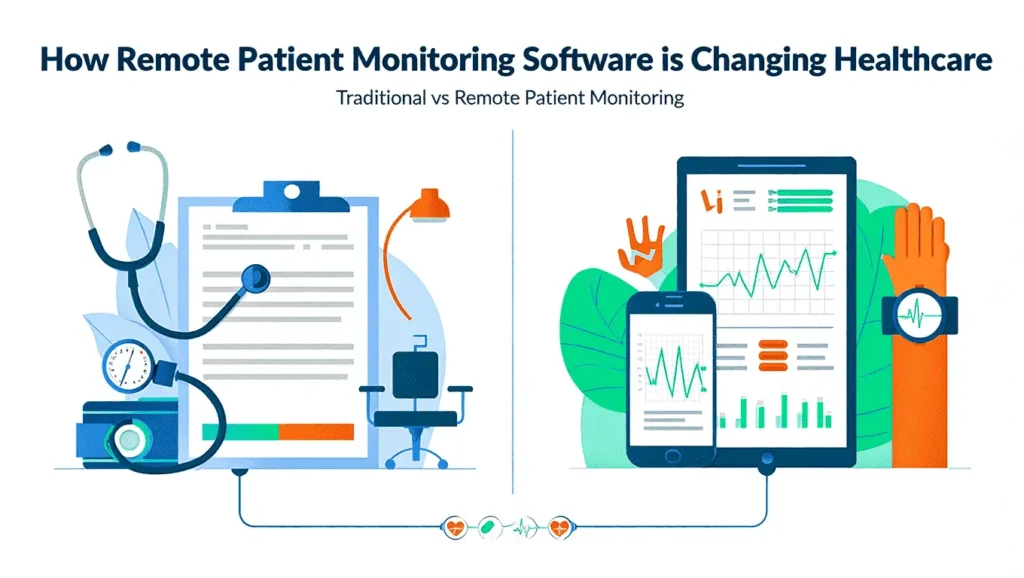
The healthcare environment is evolving at a rapid pace. Just a couple of years ago, the thought of having continuous medical management without stepping foot in the clinic seemed strange. Today, in 2025, it’s accelerating toward the new normal. What is driving the change? Digital health technologies that support healthcare, and specifically Remote Patient Monitoring (RPM) software.
What is Remote Patient Monitoring? In short, RPM is smart devices and sensors with cloud-based platforms collecting and sharing patients’ health data. It includes analyzing blood pressure, glucose levels, analyzing sleep patterns or oxygen saturation monitoring at ease.
And, why is 2025 the turning point? Let’s check it out!
- Artificial Intelligence in healthcare is growing, allowing more accurate predictive insights.
- Internet of Things health has scaled, with everything from smart watches to connected medical devices effortlessly streaming data back to RPM systems.
- Governments and insurance companies have relied highly on remote care, facilitating regulation and reimbursement of care.
Let’s check it out in detail!
Table of Contents
ToggleWhat is Remote Patient Monitoring (RPM)?
Remote Patient Monitoring (RPM) is a way to bridge your home to your healthcare provider’s office. Instead of just occasional doctor visits, RPM allows for ongoing monitoring of your health through devices.
Working of Remote Patient Monitoring Software
- Devices & Sensors: Smart blood pressure cuffs, glucose monitors, wearables, ECG patches, or smart scales logging your health information.
- Cloud Platforms: Transfers that information immediately to secure cloud platforms.
- Patient Apps: You can track your own progress, reminders, or interact with care teams.
- Provider Dashboards: Doctors and nurses are able to see trends, receive alerts, and intervene early if something is concerning.
The types of RPM data captured are:
- Blood pressure and heart rate (cardiac monitoring).
- Blood glucose levels (for diabetes management).
- Oxygen saturation and respiratory rate.
- Sleep quality and activity levels (for wellness and lifestyle tracking).
Telemedicine is virtual visits, a video visit or chat with your doctor. While, RPM allows for continuous, real-time monitoring of health. The telemedicine will have infrequent check-ins, RPM will have a steady stream.
In 2025, RPM is a highly-advanced, AI-driven, integrated platform that can do more than collecting data. They can analyze data, predict risk, and recommend personalized interventions. The evolution of RPM into a proactive health care solution rather than just a reactive solution is significant.
Why is RPM Important in 2025?
Let’s unpack some of the crucial reasons showing the importance of RPM in 2025!
Rising Chronic Disease
The burden of chronic disease (diabetes, hypertension, heart disease, etc.) is rising around the world. Now with RPM, doctors can identify red flags, such as significant spikes in blood sugar or increase in blood pressure, allowing them to intervene before the person is in danger.
Post Pandemic Shift
COVID-19 has forever changed everything in health care. During the pandemic, virtual care was a need. Patients and providers began to see that virtual care actually worked, and in a much more effective, easier manner.
Cost Efficiency
The cost of healthcare is rising. Hospitals are feeling the pressure to minimize readmissions and ER visits. RPM can help with this by identifying issues that might become escalation points, eliminating or reducing unnecessary hospitalizations while saving money.
Elderly People
Remote Patient Monitoring can allow seniors to remain at home longer while remaining connected with their care teams. Devices for their use are designed to be easy, user-friendly, and benefiting even those who are not tech-savvy.
Key Features of Modern RPM Software in 2025
If you take a moment to look back five years ago, most Remote Patient Monitoring (RPM) solutions felt haphazard-different devices, awkward apps, and limited value from the information collected. However, in 2025, the modern RPM platform is equipped with better intelligence, seamless integration, and is more patient-centric. Here is a look at the essential features!
Patient Engagement Tools
One of the most underappreciated attributes in RPM is patient engagement. Providing data is just not enough, patients must stay engaged and motivated to employ these tools.
- Mobile apps allow patients to monitor their outcomes, observe trends, and correspond with their providers.
- Patients are rewarded when they log their daily steps or stabilize their glucose levels.
- Personalized health reminders about taking medication, exercising or upcoming appointments.
- Two-way communicative pathways to directly chat with nurses or health coaches.
Safeguard Data and Meet Regulatory Requirements
Data security and compliance are foundational components of RPM platforms today. These platforms are designed with HIPAA and GDPR compliance in mind to protect patient privacy.
Data encryption is utilized to protect data during transmission and at rest. Some platforms are even exploring blockchain health records, allowing patients to manage their data in a tamper proof and transparent manner.
As a result, patients feel comfortable knowing their health data is secure, private, and under their control.
AI-Driven Predictive Analytical Capabilities
The biggest game changer for 2025 is the adoption of artificial intelligence (AI) in the health industry. The modern RPM platform can easily capture, interpret and predict data points.
For instance, instead of just recording a patient’s heart rate, AI algorithms identify subtle behaviors that can predict the chances of a cardiac disease.
Additionally, machine learning models utilize historical data and live data to warn anomalies that physicians do not see during routine examination and intervention.
Ultimately, early detection gives healthcare providers the opportunity to take measures before the health condition advances or becomes more complex.
Seamless Integration with EHRs
Nowadays, RPM software integrates seamlessly with Electronic Health Records (EHRs) to improve on this. Providers can view RPM data with clinical records to see an entire picture of the patient. As a result, it eliminates duplication, and enhances workflows.
For patients, all their health stories are integrated, whether it is data from a smartwatch or data from labs within a hospital. When silos are removed, RPM fosters continuity of care for both patients and their doctors with a complete picture of the patient’s health.
Wearables and Internet of Things in Healthcare
In 2025, wearables and IoT in health care have shifted from fitness-themed gadgets to medical partners. It includes variety of devices like:
- Smart watches can record heart rhythms, blood oxygen, and sleep cycles.
- Continuous glucose monitors (CGM) that can notify care teams when blood sugars are recorded.
- Wireless ECG patches that provide continuous monitoring of the heart.
- Smart inhalers and other respiratory devices can assist patients manage their asthma and COPD.
Automation and Alerts
One of the most significant features is automation and real time alerts. Instead of trying to manage a stream of constant data, RPM applications shift through and prioritize the information.
For example, patients receive instant notifications if there is a concern like low oxygen alert with the possibility to remove the device. Providers receive smart alerts to identify urgent concerns, along with relevant clinical data but not excess data that can lead to poor decision making.
Automated workflows also allow for interventions to occur without the pauses in coordination of care of existing procedures such as telemedicine consult planning, re-assessing treatment plans, etc.
Conclusion
Using Remote Patient Monitoring (RPM) software, healthcare software and services are evolving and enhancing the healthcare delivery system in 2025. These applications combine IoT connected devices, AI analysis, and patient engagement.
Patients benefit from ongoing monitoring, personalized and actionable insights, and engagement. Providers benefit from real-time monitoring, early intervention, and streamlined care delivery processes. On an organizational basis, RPM reduces costs, supports value-based care and increases access to effective care.
Thus, adopting Remote Patient Monitoring applications is a need for healthcare systems wanting to increase outcomes, increase patient satisfaction and reduce costs.

James Kevin is a tech writer who simplifies complex topics for readers. With a love for tech and clear communication, he helps people understand and enjoy the digital world.


